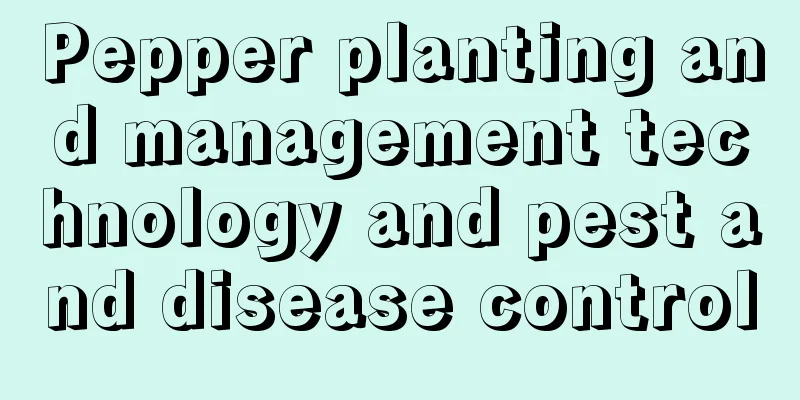Pepper planting and management technology and pest and disease control

|
Chili peppers have a large planting area in my country, and they are highly adaptable and very easy to produce high yields. When planting peppers, you must master the planting and management techniques and do a good job of disease and pest control . The following editor will introduce pepper planting and management techniques and disease and pest control. Let’s take a look. 1. Pepper planting and management technology 1. Site selection and land preparation Choose fertile, deep sandy loam with good water and fertilizer retention capabilities. Avoid continuous cropping with crops that are prone to pests and diseases. Land preparation work is usually carried out in autumn, including ploughing, irrigation and deep turning of the soil to ensure that the soil is flat and fine. In spring, turn the soil again, remove debris, and use mechanical operations to harrow and compact the soil. 2. Seed selection and seedling raising Choose pepper varieties that are high-yielding, highly adaptable and commercially viable. Select full seeds, soak them in clean water for 30 minutes to remove shriveled and diseased seeds, then disinfect them with 1% copper solution or 10% trisodium phosphate solution for 10 minutes. After washing, soak the seeds in the solution for 8 hours. Finally, wash and wrap them with wet gauze for germination. The soaked seeds are germinated at 30℃ for 36 hours, and turned over regularly to ensure uniform germination. The nursery area should account for 1.5% of the field area. Before sowing, ensure that the seedbed is moist, irrigate with sufficient bottom water, and maintain good drainage and irrigation conditions. 3. Planting The suitable period for transplanting is early to mid-April. The row spacing should be maintained at 60×70cm, or 50×60cm. The distance between holes should be about 30cm. It is appropriate to plant 2-3 pepper seedlings in each hole. After planting, water the plants in time to maintain appropriate density and avoid overcrowding. Spraying the new lipid film can effectively prevent water evaporation, shorten the seedling period, and promote the healthy growth of peppers. During the growth process of peppers, key watering is required, such as planting water, seedling growth water, seedling squat water, fruit swelling water and pruning water. At other times, water flexibly according to soil conditions and follow the principle of "watering when soil is dry". 4. Fertilization management Base fertilizer is mainly organic fertilizer , such as decomposed animal manure or plant residues, to improve soil structure. Apply organic fertilizer and appropriate amount of quick-acting nitrogen fertilizer, such as urea, during the seedling stage to promote seedling growth. In the middle and late stages of growth, trace elements and growth regulators such as alginate and potassium dihydrogen phosphate can be supplemented through foliar spraying. 2. Pepper pest and disease control 1. Disease Choose pepper varieties with strong disease resistance, disinfect them before planting, cultivate sterile seedlings, spray protective agents on the day of planting to avoid the occurrence of diseases, and kill residual pathogens in the soil through high temperatures. 2. Botrytis cinerea In the early stage of the disease, diseased branches and leaves should be removed promptly, and destroyed in a centralized manner after being transported out of the planting site. Use low-toxic pesticides for prevention and control. When using pesticides, control the concentration and dosage to avoid pesticide residues. 3. Bacterial wilt The effect of water-land rotation in preventing bacterial wilt is quite significant. At the same time, the soil should be improved and alkalinity should be increased to reduce the incidence of bacterial wilt. Enhance the disease resistance of pepper seedlings through scientific cultivation techniques, and select effective agents for prevention and control. 4. Scab Implement 2-3 year crop rotation with non-Solanaceae vegetables, combine with deep tillage, and pay attention to inter-row tillage and loosening of the soil after planting to promote root development. Seeds can be disinfected by soaking in 55℃ warm water for 15-30 minutes. In the early stage of the disease, fungicides such as fenpropimorph and quinclorac are used for prevention and control. 5. Pest control Leaf miners will reduce the number of peppers planted per unit area. To ensure smooth air circulation, natural enemies and pesticides can be used to kill leaf miners. Use imidacloprid spray to control aphids, and use cypermethrin or cypermethrin and trichlorfon for root irrigation to control underground pests. The above are the pepper planting and management techniques and disease and pest control. Farmers can also control the vigorous growth of plants through pruning, appropriate fertilization and reasonable watering, and spray potassium dihydrogen phosphate foliar fertilizer and growth regulators such as brassinolide during the peak fruiting period to promote root development and fruit growth.
|
<<: How to prevent and treat green algae in the fish tank?
>>: Litchi seedling planting technology
Recommend
Phoenix breeding methods and precautions
The Phoenix is also called the Fallen Root Plan...
How to fertilize Begonia, what fertilizer is best
1. Fertilization time The best time to fertilize ...
Peanut planting and management technology Peanut high-yield cultivation technology and management methods
Sowing time Climate conditions vary from place to...
Breeding methods and precautions of Black Prince
soil It is suitable to be cultivated in sandy soi...
What are the methods and precautions for breeding the high-speed
Introduction to Step by Step The kaempferia ovata...
How much do hydrangeas usually cost?
1. Main influencing factors Hydrangea is a very f...
The difference between Lycopodium and Lycopodium
1. Difference of blades The leaves of Lycopodiell...
How much does a crape myrtle tree cost? Pictures of crape myrtle
1. How much does a crape myrtle tree cost? Genera...
Can firecracker flowers bloom in winter?
Key point 1. Soil It has a relatively large deman...
Differences between Pyracantha and Seabuckthorn
Different genus and species Pyracantha is a plant...
How much is the yield of mustard per mu? What is the normal profit of planting one mu of shepherd's purse?
Yield of mustard per mu Mustard is harvested in b...
What to do if the leaves of poinsettia turn yellow
The yellowing of poinsettia leaves is due to the ...
Can Polygonatum be potted?
Can Polygonatum be planted in pots? Polygonatum s...
What flowers are suitable for growing in Chengdu? What are the city flowers and trees?
1. Chengdu’s Climate Characteristics Chengdu has ...
The best way to store Chinese cabbage Tips for storing fresh Chinese cabbage at home
How to store Chinese cabbage The lowest temperatu...









